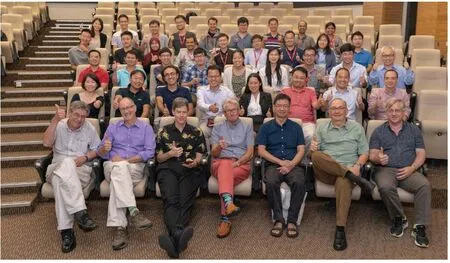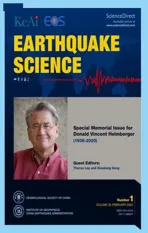My seismology journey with Donald V. Helmberger
2022-05-03ShengjiWei
Shengji Wei
Asian School of the Environment/Earth Observatory of Singapore Nanyang Technological University, Singapore 639798,Singapore
My journey on the wiggles with Don started from February 2008, when I got an opportunity to visit the Caltech Seismolab as a visiting PhD student, which was made possible via Dr. Sidao Ni’s recommendation. A previous student of Don, Sidao was a professor at the School of Earth and Space Sciences (ESS) at the University of Science and Technology of China (USTC) at that time. Sidao offered the “Computational Seismology”class at USTC where I learned a lot about the modern developments in seismology. I also met Sidao many times to discuss a wide range of research topics, I believe it is a style he inherited from his experiences with Don and other professors in Seismolab.
My first time seeing Don was in the printing room of the Seismolab, where I shook his hand and say hi to him,he told me that you speak good English. I was quite shocked, as I was barely able to say a complete sentence with my Chinese accent. Later on, we were joking that Don’s English had been brought down so much by his Chinese students that an international student can easily impress him with speaking English. I was also wondering,maybe the seismograms are the best language that Don communicated with his students.
My first project with Don was to look into the seismograms produced by the 2008MW6.0 Nevada earthquake, through which I learned how to understand the seismograms in his unique ways. The USArray had been translated to the mid-western US at the time of the earthquake, hence hundreds of stations recorded the earthquake including the permanent stations in the western US. I ran the Cut-And-Paste code (Zhu LP and Helmberger, 1996; Zhao LS and Helmberger, 1994) using these seismograms to get the moment tensor solution. As a beginner in waveform seismology aiming for a robust point source focal mechanism solution of the earthquake, I discarded lots of “bad” fits and was quite happy with the nice waveform fits using a 1D velocity model. After telling me that these nice Pnl fits were the multiples of the Moho reflection phases and depth phases, Don quickly shifted his interests to those waveforms that I discarded. He asked me to organize the waveforms in various ways, and a few weeks later, out of these discarded waveforms that were recorded by the stations along the northwestern coast, he identified multi-pathing phases that sampled the subducting Juan de Fuca slab. At that moment, theMW7.9 Wenchuan earthquake occurred and my interest and time was completely absorbed by the large earthquake source study. Thankfully, Dr. Risheng Chu continued analyzing the multi-pathing observations and eventually got them published (Chu RS et al., 2012).
Time flew quickly to the end of my one-year visit, I started several projects with Don in these 12 months, but none of them finished. Before I went back to USTC to wrap up my thesis, I told Don that if he has a postdoc position for me, I will for sure come back. Fortunately, he did. Now I look back to this process as a faculty member, I can not appreciate enough Don’s trust, as I had only published one paper in the Chinese Journal of Geophysics that he could not read at the moment he offered me the position. This experience also later on shaped my way to select postdoc and student candidates at NTU.
I went back to the Seismolab on September 16, 2009,for my dream job to continue working with Don as a postdoc, mostly on large earthquake kinematic source study. That was a hectic period of earthquake source study in the lab, several damaging earthquakes occurred during my postdoc time, including El Mayor Cucapah earthquake in 2010 (Wei SJ et al., 2011), New Zealand earthquakes in 2010 and 2011 (Zhan ZW et al., 2011), Tohoku-Oki earthquake in 2011 (Wei SJ et al., 2012), Wharton Basin earthquake in 2012 (Wei SJ et al., 2013a), Brawley earthquake sequence in 2012 (Wei SJ et al., 2013b, 2015)and Sea of Okhotsk earthquake in 2013 (Wei SJ et al.,2013b). In these studies, I continued learning from Don on how to breakdown the complex waveforms produced by these earthquakes to make more sense from the inversion and modeling results. I also learned to find and appreciate the clean paths for earthquake source study at as high frequency as I could. Figure 1 is one of such examples(modified from Wei SJ et al., 2015), through which I realized 3D velocity models may not work well and path calibration is frequency dependent, and we still have a lot to learn on the Earth structure. In these projects, I also greatly benefitted from collaborations with Jean-Philippe Avouac, Rob Graves, Eric Fielding, Ken Hudnut and many other colleagues and visitors at the Seismolab. Coffee hours in the lab were the place that I could hear and participate in the most genuine scientific discussions,where Hiroo most frequently provided materials on earthquakes and stimulated a related discussion but many times ended up with something else. I gradually realized these benefits as I continued my academic career as a faculty, and I believe that coffee hour makes the Caltech Seismolab an unparalleled place for geoscience research.

Figure 1. Path calibration example for Brawley earthquake sequence study (modified from Wei SJ et al., 2015). (a)Representation of the parameterized velocity models. (b) Grid search result for the vertical and radial component. (c) 1Hz PSV waveform (black) of the Mw4.4 calibration event and synthetics (red) calculated with the calibrated 1D model and 1D velocity models extracted from CVM4.0 (middle) and CVMH11.9 (bottom). Note the surface multiples and the surface waves in the data are well fitted by the synthetics.

Figure 2. Helmberger academia family photo after the August, 2018 workshop in Nanyang Executive Center (NTU). Row 1(left-to-right) Stephen Grand, Edward Garnero, John Vidale, Don Helmberger, Xiaodong Song, Charles Langston, Thorne Lay; Row 2, Ying Tan, Teh-Ru Alex Song, Ali Ozgun Konca, Zhongwen Zhan, Min Chen, Chen Ji, Sidao Ni, Brian Savage;Row 3, Xuhua Shi, Lianxing Wen, Daoyuan Sun, Justin Yen-Ting Ko, Voon Hui Lai; Liqing Jiao; Yongsheng Liu, Shengji Wei, Lupei Zhu; Row 4, Xin Wang, Yingyu Qi, Wardah Fadil, Muzli Muzli, Qibin Shi, Ping Tong, Xueyuan Huang, Farm Hui Jia, Shaolin Liu; Row 5, Hsin-Ying Yang; Jiayuan Yao, Hongyu Zeng, Weiwen Chen, Phyo Maung-Maung, Meng Chen,Chung-han Chan, Rishav Mallick, Priyamvada Nanjundiah.
Since I became a PI at the Earth Observatory of Singapore (EOS) and a faculty at NTU in 2014, the way that I work with my students and postdocs is deeply shaped by my experiences with Don. I like to meet frequently with my group members, trying to transfer as much as I know to them, but also learning from them. The idea of calibrating on the paths, cutting and pasting seismograms was further generalized to a Multiple Point Source McMc-based inversion method (Shi QB et al.,2018); the high frequency waveform modeling/inversion experiences stimulated a project on trying to merge the gaps between back-projection and deterministic waveform analysis (Zeng HY et al., 2020).
In 2018, I learned that other places did not have a plan to arrange a retirement workshop for Don so I wrote a proposal to apply for some EOS internal grant for such a workshop. The workshop was held in August 2018, at the time that NTU implemented many new policies, including on the ways to use the approved budgets. With support from Kerry Sieh, who was the director of EOS and also a colleague of Don for many years at Caltech, we went through some key logistical difficulties and eventually made it happen. I also appreciate the great help from my secretary Linda Chua, this workshop would not happen without her detailed arrangements and encouragements.When everyone was in Singapore and I saw all the big smiles ((Figure 2), of course, some tears as well, and interesting and touching presentations, I felt that organizing the workshop is one of the most correct things that I have ever done.
Don’s deep understanding and insights of waveform seismology do not fade away with his passing, instead,they become even more valuable in the era of big data. It is, however, also a great challenge to reconcile massive data processing and thorough digestion of the wiggles. At EOS, my research mostly focuses on SE Asia, where so many knowledge gaps exist, for instance, the Sagaing fault and Sumatran fault are similar to the San Andreas Fault, in terms of their potential large earthquakes and associated risks to huge population, but only a few tens of seismological papers have been published on these plate boundary type of faults in SE Asia. With usage of dense array and powerful computers, it is a great opportunity for modern seismology development in SE and hopefully, an extension of Don’s legacy.
杂志排行
Earthquake Science的其它文章
- A graduate student experience with Professor Donald V.Helmberger
- Exploring Earth’s boundaries with Donald V.Helmberger
- A strange symbiosis: Seismic ray theory and Saturday touch football — Donald V. Helmberger as a graduate advisor
- Donald V. Helmberger memoir — exceptional seismologist, teacher, mentor, friend
- Recollections of my mentor, Donald V. Helmberger
- A grand master of seismology and mentoring
